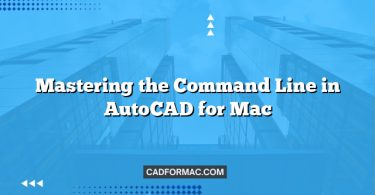Creating a functional and aesthetically pleasing kitchen layout is a foundational step in any residential design project. AutoCAD for Mac offers powerful drafting tools that allow designers to produce precise, scalable, and professional kitchen plans. Whether you’re an architect, interior designer, or DIY enthusiast, this step-by-step guide will walk you through designing a kitchen layout from scratch using AutoCAD on macOS.
Before You Begin: Setup and Planning
- Gather Measurements
Accurately measure the room dimensions, door and window locations, and existing plumbing or electrical fixtures. Note ceiling height if planning for tall cabinets or soffits. - Understand Kitchen Workflow
Follow the “kitchen work triangle” principle: the sink, stove, and refrigerator should form a triangle with total perimeter between 12 and 26 feet for optimal efficiency. - Launch AutoCAD for Mac
Open AutoCAD and create a new drawing using the acad.dwt or acadiso.dwt template (imperial or metric, respectively).
Step 1: Set Up Your Drawing Environment
- Set Units
- Go to Format > Units (or type
UNITSin the command line). - Choose your unit type (e.g., Architectural for feet/inches or Decimal for metric).
- Set precision to 1/16″ or 0.00 as needed.
- Go to Format > Units (or type
- Configure Layers
Organize your drawing with layers for clarity:- Walls (color: red)
- Cabinets (color: blue)
- Appliances (color: green)
- Fixtures (color: magenta)
- Dimensions (color: cyan)
- Text/Notes (color: black)
Use Layer Properties Manager (
LAYERcommand) to create and assign colors.
Step 2: Draw the Room Outline
- Draw Exterior Walls
- Activate the Walls layer.
- Use the Line (
LINE) or Polyline (PLINE) command to draw the outer perimeter of the kitchen. - For example, type
LINE, click a starting point, then enter coordinates or distances (e.g.,@12'0",0for a 12-foot wall).
- Add Interior Features
- Draw windows and doors using the Rectangle (
RECTANG) or Arc (ARC) tools. - Represent windows as breaks in the wall with short lines or use blocks if available.
- Draw windows and doors using the Rectangle (
Step 3: Place Major Appliances and Fixtures
- Insert Standard Symbols
AutoCAD for Mac includes basic blocks, but you may need to download or create kitchen-specific symbols (sink, stove, fridge, dishwasher). - Use Blocks for Efficiency
- Create blocks for each appliance:
- Sink: 30″ wide × 24″ deep
- Refrigerator: 36″ wide × 30″ deep
- Range: 30″ wide × 25″ deep
- Draw each appliance using Rectangle, then convert to a block via Block > Create (
BLOCKcommand).
- Create blocks for each appliance:
- Position According to Workflow
Place the sink near a window if possible, keep the fridge near the entry, and ensure at least 42″ of clearance in front of appliances.
Step 4: Design Cabinetry Layout
- Base Cabinets
- Standard depth: 24″
- Standard height: 34.5″ (plus 1.5″ countertop = 36″ total)
- Use Rectangle to draw cabinet runs along walls.
- Add internal divisions for drawers or doors using Line.
- Wall Cabinets
- Typically 12″ deep, mounted 18″ above countertop (54″ from floor)
- Draw above base cabinets using offset lines or copy commands.
- Island or Peninsula (if applicable)
- Ensure at least 36–48″ clearance around all sides.
- Include overhang for seating if desired (add 12″ beyond base cabinet depth).
Tip: Use Offset (
OFFSET) to quickly create cabinet outlines from wall lines.
Step 5: Add Countertops and Details
- Countertop Outline
- Draw a polyline around the top surface of base cabinets and island.
- Assign to a Countertops layer (optional).
- Backsplash
- Represent with a thin line or hatch above wall cabinets or along exposed walls.
- Hatch for Materials (Optional)
- Use Hatch (
HATCH) to indicate tile, wood, or stone surfaces. - Choose patterns from the Hatch Creation tab.
- Use Hatch (
Step 6: Dimension and Annotate
- Add Dimensions
- Switch to the Dimensions layer.
- Use Linear Dimension (
DIMLINEAR) to label wall lengths, cabinet widths, and clearances. - Ensure critical measurements (e.g., work triangle legs) are clearly marked.
- Add Text Notes
- Use Multiline Text (
MTEXT) to label appliances, materials, or design notes (e.g., “Quartz Countertop,” “Soft-Close Drawers”).
- Use Multiline Text (
Step 7: Review and Finalize
- Check Clearances
Verify walkways are at least 36″ wide (42″ for two people). Ensure appliance doors can open fully. - Audit Your Layers
Freeze or turn off unnecessary layers for a clean print. - Plot or Export
- Go to Output > Plot to print or create a PDF.
- Set paper size (e.g., 11×17 or A3), scale (e.g., 1/4″ = 1′-0″), and include a title block if needed.
Bonus Tips for AutoCAD Mac Users
- Use Dynamic Input: Toggle with
F12for on-screen coordinate entry. - Leverage DesignCenter: Access pre-made blocks via View > Palettes > DesignCenter.
- Save Templates: Once your layer setup and units are perfect, save as a
.dwtfile for future kitchen projects. - Sync with Cloud: Save to Autodesk Drive or iCloud for access across devices.
FAQ: Designing a Kitchen Layout in AutoCAD for Mac
Below are common questions specifically related to creating kitchen layouts in AutoCAD for Mac—addressing gaps not covered in the main guide.
Q1: Does AutoCAD for Mac support dynamic blocks for kitchen cabinets like the Windows version?
A: Yes, AutoCAD for Mac fully supports dynamic blocks, including visibility states, stretch actions, and lookup parameters. However, the Block Editor interface differs slightly. To create or edit dynamic blocks, go to Insert > Block Definition > Block Editor. You can build parametric cabinets that adjust width, height, or door style—ideal for quickly iterating kitchen designs.
Q2: Can I import manufacturer-specific appliance or cabinet models into AutoCAD for Mac?
A: Absolutely. Many kitchen and appliance manufacturers (e.g., IKEA, Bosch, Sub-Zero) provide 2D CAD blocks or 3D models in DWG or DXF format. Download these from their official websites or platforms like BIMobject or Autodesk Seek. Use Insert > DWG Reference or simply drag and drop the file into your drawing. Ensure units match your project settings to avoid scaling issues.
Q3: How do I ensure my kitchen layout complies with local building or accessibility codes in AutoCAD?
A: While AutoCAD doesn’t auto-check code compliance, you can enforce standards manually:
- Use annotative dimensions to clearly mark clearances (e.g., 30″ minimum in front of sinks).
- Create a dedicated Code Check layer with reference lines (e.g., 60″ turning radius for wheelchair access per ADA).
- Overlay checklist notes using MTEXT. For rigorous compliance, consider pairing AutoCAD with specialized software like Revit or consulting local code documents during design.
Q4: Is it possible to generate a materials takeoff or cabinet schedule directly in AutoCAD for Mac?
A: AutoCAD for Mac doesn’t include automated scheduling tools like AutoCAD Architecture (Windows-only), but you can create a basic schedule manually:
- Assign consistent attributes to cabinet blocks (e.g.,
CAB_TYPE,WIDTH,DEPTH) using the ATTDEF command. - After placing all cabinets, use Tools > Extract Data (
EATTEXT) to export attributes to a CSV file. - Open the CSV in Numbers or Excel to build your takeoff list. This requires upfront block planning but is effective for small to mid-sized projects.
Q5: Why do my lineweights or colors look different when I print or export to PDF from AutoCAD for Mac?
A: This often stems from plot style settings. AutoCAD for Mac uses CTB (color-dependent) plot styles by default. To fix:
- Go to Output > Plot Style Manager.
- Assign a
.ctbfile (e.g.,monochrome.ctbfor black-and-white prints). - In the Plot dialog, ensure “Plot with Plot Styles” is checked.
- Preview before exporting to confirm lineweights and colors appear as intended.
Q6: Can I use AutoCAD for Mac to design a kitchen in 3D and still produce 2D construction drawings?
A: Yes. While the main guide focuses on 2D, AutoCAD for Mac supports 3D modeling. You can:
- Model cabinets and countertops using Box, Extrude, or PressPull.
- Switch to a Layout tab and create 2D orthographic views (plan, elevation) using ViewBase or Flatshot.
- However, for complex cabinetry, many designers prefer to finalize 2D plans first, then add 3D only for client visualization.
These FAQs address practical, platform-specific concerns that often arise during real-world kitchen design projects in AutoCAD for Mac—helping you avoid common pitfalls and leverage the software’s full potential.
Conclusion
Designing a kitchen layout in AutoCAD for Mac combines precision drafting with smart spatial planning. By following this structured workflow—setting up layers, placing key elements, and annotating clearly—you’ll produce professional-grade plans ready for client review or contractor use. With practice, you’ll streamline the process and even develop a library of custom blocks and templates to accelerate future projects.
Note: AutoCAD for Mac may have slight interface differences from the Windows version, but core commands remain consistent. Always refer to Autodesk’s official documentation for version-specific features.




